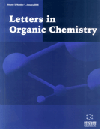- Home
- A-Z Publications
- Letters in Organic Chemistry
- Issue Home
Letters in Organic Chemistry - Current Issue
Volume 22, Issue 4, 2025
-
-
How Enzyme Selectivity and Immobilization Affect Catalytic Yields in Lipase-Catalyzed Processes
More LessHerein, the influence of structural attributes, including the interactions of lipases with support systems, substrates, products/byproducts, and the media environment, on enzyme stability, selectivity and activity are discussed. Substrates/products, such as methanol, glycerol, phenolic acids and polyphenols, can inhibit lipase activity by influencing the mass flow of the reactants and products or by enzyme denaturation, which is al Read More
-
-
-
Innovative Synthesis of 3,5-Disubstituted Pyrazoline with Heterocyclic System for Hybrid Development
More LessThe synthesis of 3,5-disubstituted pyrazolines, integrated with heterocyclic systems, represents a crucial area of chemical research due to their pharmacological and biological significance. This article reviews various synthetic methods used to prepare 3,5-disubstituted pyrazolines with different heterocyclic groups. The methodology employed in this study entails a multi-step synthesis, where readily available starting ma Read More
-
-
-
Photochemical Dimerization of Indones: A DFT Study
More LessIn this study, DFT calculations were performed in order to identify the reaction products of the photochemical dimerization of indones. Calculations allowed us to assume that all tested reactions occurred in the first excited singlet state. The irradiation of 2-phenyl-5-nitroindone gave the main product, the anti-cis head-to-tail dimer, while the other two compounds found in the experiments were the syn-cis head-to-head dimer a Read More
-
-
-
Iodine Promoted Desulfurization of Isothiocyanate in Water: Synthesis of 5-Amino-1-Aryl/Alkyl Tetrazoles, Aryl/Alkyl Guanidines and their Conversion
More LessAuthors: Hema Kumar Venkata K, Janardan Sannapaneni and Ramana TamminanaA general and efficient multi-component reaction has been established for the construction of 5-amino tetrazoles and guanidines under mild reaction conditions. All the substrates are readily carried out under optimized reaction conditions to provide their respective target products in good to excellent yields. The regioselectivity of the reaction is also explained in this manuscript. Further, this method is free, uses water Read More
-
-
-
Rapid and Metal-Free Green Synthesis of Coumarins Catalyzed by Humic Acid
More LessAuthors: Ling Wei, Yichun Wang, Qixuan Huang and Hongshe WangIn recent years, numerous methods have been developed for the synthesis of coumarins via Pechmann reaction catalyzed by various catalysts. Although each of the synthetic strategies previously reported has its own merit, most of these methods are associated with certain disadvantages, including the use of commercially unavailable metal catalysts and organic solvents, low yields, and long reaction times. Therefore, the d Read More
-
-
-
Copper-Catalyzed Synthesis of Quinazolin-4(1H)-one from Amine-Trichloroacetonitrile Adduct and Isatoic Anhydride
More LessA rapid and direct route for the new synthesis of various quinazolines-4 (1H)-ones with appropriate yields through a three-component reaction consisting of the amine-trichloroacetonitrile adduct and isatoic anhydride is a remarkable achievement in organic chemistry. The use of CuO as the catalyst in DMF under reflux conditions at 110°C for 4 hours offers reaction conditions, which are conducive to the formation of the desir Read More
-
-
-
Ce(OTf)3-Catalyzed Synthesis of Glucopyranurono-6,1-Lactone: A Key Intermediate for Obtaining Glycoconjugates of Peptidic Fragments of Arenastatin A
More LessAuthors: A. Mezrai, L. Mrah, Z. Khiati and A. KenicheIn this work, 2,3,4-tri-O-acetyl-D-glucurono-6,1-lactone has been prepared from glucuronic acid in two steps by converting it into glucuronic anhydride. In the presence of a catalytic amount of Ce(OTf)3 (10 examples) in ethyl acetate, the glucuronic anhydride provided 6.1-lactone in good to excellent yields. This lactone was used to prepare the novel glycoconjugates of peptidic fragments of arenastatin A, a sponge cytotoxi Read More
-
-
-
Synthesis of Fused Pyrrolo-napthridinone via Ligand-free Copper Catalysed Ullmann (C-N coupling) Type Reaction
More LessAuthors: Mekala Ramesh and Malempati SrimannarayanaFused pyrrole, pyridine with pyridinone components are known to possess many biological and pharmaceutical properties. Fused pyrrole with naptharidinone also has many potentials. A tandem approach of intramolecular lactamization and N-arylation using a copper catalyst to obtain a fused pyrrolo-naptharidinone has been developed. A ligand-free method has been proposed for cyclization and Ullmann (C-N coupling) t Read More
-
-
-
An Efficient Metal-Free Methodology for the Synthesis of Hydrazo-Linked 5-(4-aryl)-1H-1,2,4-Triazoles
More LessAuthors: Neha Rani, Deepak K. Aneja, Mayank Kinger, Rinku Soni, Monika Sihag, Sandeep Malik and Kirti BhardwajHydrazo compounds have displayed significant roles in both biological and physical aspects, such as spinamycin as a potent growth inhibitor against fungi and rat sarcoma cells, hydrazo tocopherol as a component of vitamin E, and electron-rich hydrazo-linked triazines as energetic materials. In this study, a metal-free approach was proposed for the synthesis of hydrazo-linked 5-(4-aryl)-1H-1,2,4-triazoles. The methods for the sy Read More
-
Volumes & issues
-
Volume 22 (2025)
-
Volume 21 (2024)
-
Volume 20 (2023)
-
Volume 19 (2022)
-
Volume 18 (2021)
-
Volume 17 (2020)
-
Volume 16 (2019)
-
Volume 15 (2018)
-
Volume 14 (2017)
-
Volume 13 (2016)
-
Volume 12 (2015)
-
Volume 11 (2014)
-
Volume 10 (2013)
-
Volume 9 (2012)
-
Volume 8 (2011)
-
Volume 7 (2010)
-
Volume 6 (2009)
-
Volume 5 (2008)
-
Volume 4 (2007)
-
Volume 3 (2006)
-
Volume 2 (2005)
-
Volume 1 (2004)
Most Read This Month Most Read RSS feed
Article
content/journals/loc
Journal
10
5
false
en


